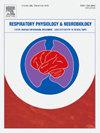Cockroach allergen exposure alters redox homeostasis and mediates airway inflammation
IF 1.6
4区 医学
Q3 PHYSIOLOGY
引用次数: 0
Abstract
Allergic diseases are orchestrated by complex interplay of allergens with components of immune system as well as structural cells. As airway epithelium lies at the interface of environment and host immune responses, therefore we sought to study role of cockroach allergen exposure in context of oxidative stress in epithelia and its functional role in allergic pathophysiology. In vitro studies on Beas2B cells indicated elevation of intracellular ROS levels upon cockroach allergen (CE) exposure and transcriptional regulation of epithelial activation markers (CXCL-8 and IL-1 α) and endogenous antioxidant SOD-2. To corroborate ROS induction in vivo, mice model of cockroach hypersensitivity was generated and cytosolic and mitochondrial superoxide levels in lung of mice were estimated along with markers of allergic inflammation (cellular infiltration and epithelial activation cytokines (IL-33, TSLP and IL-25), proinflammatory (Th2 cytokines) and antioxidant pathways. Antioxidant supplementation with NAC, GSH and mitochondria specific ROS scavenger Mito-Tempo significantly reduced allergic inflammation. To discern the role of antioxidant pathways, we examined Nrf2 and SOD2 levels in mice lungs. Our results indicate that cockroach allergen exposure offsets the redox balance in lung with reduced glutathione peroxidase and catalase levels, however antioxidant treatment was able to restore redox equilibrium in lung by upregulating the expression of major regulator of antioxidant signalling, Nrf2 and enzymatic antioxidant SOD2. Our studies indicate crucial role of cockroach allergen induced ROS in allergic pathophysiology and targeting allergen induced oxidative stress may be utilised as an adjunct therapy for allergic diseases.
蟑螂过敏原暴露改变氧化还原稳态和介导气道炎症
变应性疾病是由过敏原与免疫系统成分以及结构细胞的复杂相互作用精心策划的。由于气道上皮处于环境和宿主免疫反应的界面,因此我们试图研究蟑螂过敏原暴露在上皮氧化应激背景下的作用及其在过敏病理生理中的功能作用。Beas2B细胞的体外研究表明,蟑螂过敏原暴露后细胞内ROS水平升高,上皮活化标志物(CXCL-8和IL-1 α)和内源性抗氧化剂SOD-2的转录调节。为了证实ROS在体内的诱导作用,我们建立了蟑螂超敏小鼠模型,测定了小鼠肺细胞浆和线粒体超氧化物水平以及变应性炎症(细胞浸润和上皮活化细胞因子(IL-33、TSLP和IL-25)、促炎(Th2细胞因子)和抗氧化途径的标志物。添加NAC、GSH和线粒体特异性ROS清除剂Mito-Tempo的抗氧化剂可显著减轻过敏性炎症。为了辨别抗氧化途径的作用,我们检测了小鼠肺中Nrf2和SOD2的水平。我们的研究结果表明,暴露于蟑螂过敏原会通过降低谷胱甘肽过氧化物酶和过氧化氢酶水平来抵消肺中的氧化还原平衡,而抗氧化处理能够通过上调抗氧化信号的主要调节因子Nrf2和酶促抗氧化剂SOD2的表达来恢复肺中的氧化还原平衡。我们的研究表明,蟑螂过敏原诱导的ROS在过敏病理生理中起着至关重要的作用,靶向过敏原诱导的氧化应激可作为过敏性疾病的辅助治疗方法。
本文章由计算机程序翻译,如有差异,请以英文原文为准。
求助全文
约1分钟内获得全文
求助全文
来源期刊
CiteScore
4.80
自引率
8.70%
发文量
104
审稿时长
54 days
期刊介绍:
Respiratory Physiology & Neurobiology (RESPNB) publishes original articles and invited reviews concerning physiology and pathophysiology of respiration in its broadest sense.
Although a special focus is on topics in neurobiology, high quality papers in respiratory molecular and cellular biology are also welcome, as are high-quality papers in traditional areas, such as:
-Mechanics of breathing-
Gas exchange and acid-base balance-
Respiration at rest and exercise-
Respiration in unusual conditions, like high or low pressure or changes of temperature, low ambient oxygen-
Embryonic and adult respiration-
Comparative respiratory physiology.
Papers on clinical aspects, original methods, as well as theoretical papers are also considered as long as they foster the understanding of respiratory physiology and pathophysiology.

 求助内容:
求助内容: 应助结果提醒方式:
应助结果提醒方式:


